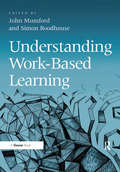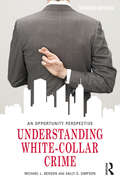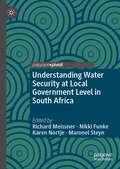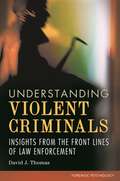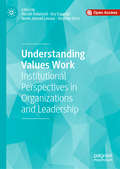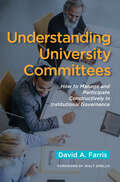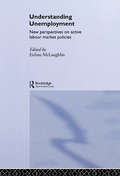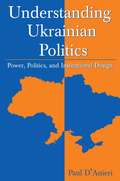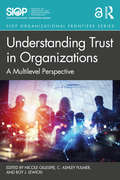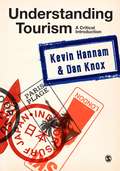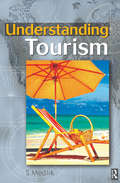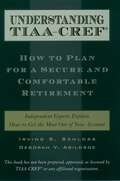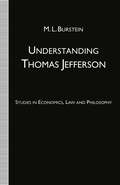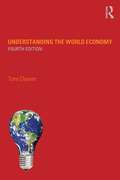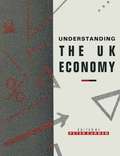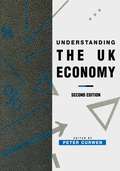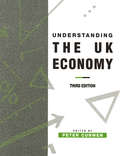- Table View
- List View
Understanding Work-Based Learning
by John MumfordThis important book is for anyone who wants to make the most of work-based learning: employees, employers, educationalists, policy makers and researchers. It sheds light on ways of giving full-time employees the chance to take up learning opportunities which are of the same level and rigour as those on offer to the full time student. It approaches the subject from the perspective of the learner, drawing on case studies to provide detailed insight. It suggests that universities already have in place much of the machinery needed to support learners who are in work: they just don't make enough use of it. Look closely and you will find a substantial legacy of this kind of activity by universities. This is a book about seizing opportunities. In one volume, Understanding Work-Based Learning makes a valuable contribution to current employer engagement and learner demand debates, and provides first hand learner experiences to guide existing and potential work based learners, employers, educationalists, policy makers, and researchers.
Understanding White-Collar Crime: An Opportunity Perspective
by Michael L. Benson Sally S. SimpsonUnlike other books of its kind, Understanding White-Collar Crime: An Opportunity Perspective uses a coherent theoretical perspective in its coverage of white-collar crime. Using opportunity perspective, or the assumption that all crimes depend on offenders having some sort of opportunity to commit an offense, allows the authors to uncover the processes leading up to white-collar crimes and offer potential solutions to this rampant issue, without being reductive in their treatment of the topic. With this second edition, Benson and Simpson have greatly expanded their coverage to include new case studies, substantive materials, and an annotated appendix of online resources to make this a core book for courses on white-collar crime.
Understanding White-Collar Crime: An Opportunity Perspective
by Michael L. Benson Sally S. SimpsonUnlike other books of its kind, Understanding White-Collar Crime: An Opportunity Perspective uses a coherent theoretical perspective in its coverage of white-collar crime. Using opportunity perspective, or the assumption that all crimes depend on offenders having some sort of opportunity to commit an offense, allows the authors to uncover the processes leading up to white-collar crimes and offer potential solutions to this rampant issue, without being reductive in their treatment of the topic. With this second edition, Benson and Simpson have greatly expanded their coverage to include new case studies, substantive materials, and an annotated appendix of online resources to make this a core book for courses on white-collar crime.
Understanding Water Security at Local Government Level in South Africa
by Richard Meissner Nikki Funke Karen Nortje Maronel SteynThis book provides unique insights into the complex issue of water security in South Africa. Based on qualitative research conducted through face-to-face structured interviews and focus group discussions with individuals, traditional leaders, municipal officials, researchers, businesspeople and farmers in the two local governments – the Sekhukhune District and eThekwini Metropolitan Municipalities – it focuses on the peoples’ understanding of the concept of water security and whether they believe that the municipalities have achieved water security for all. The research is supported by water security-related statistics, particularly those pertaining to water quality and quantity, and an extensive literature review for the concept of water security. In addition to assessing the state of water security in both municipalities, the book presents a new water security definition and typology, and offers valuable recommendations for future research.
Understanding Violent Criminals: Insights from the Front Lines of Law Enforcement (Forensic Psychology)
by David J. ThomasWhat causes people to commit violent crimes? The case studies in this book enable readers to evaluate the motivations behind crimes ranging from arson to rape to gang violence.Violent crime remains a major problem in America: in 2011, there were more than 1.2 million violent crimes committed in the United States. To better grasp the complex reasons behind this disturbing statistic, author David J. Thomas—a police officer and forensic psychologist—conducted an in-depth examination of violent crime to pinpoint why some individuals intentionally inflict pain and suffering upon others. In this book, readers are given access to excerpts from police interviews for each spotlighted crime in the case studies, offering a unique inside look at the true motivations of the criminal. The case studies include examples of arson, crimes against children, gang violence, human trafficking, murder, rape, and robbery. The work also explores the psychology associated with each crime, addresses evidence of corresponding personality types, and delves into victimology.
Understanding Violent Criminals: Insights from the Front Lines of Law Enforcement (Forensic Psychology)
by David J. ThomasWhat causes people to commit violent crimes? The case studies in this book enable readers to evaluate the motivations behind crimes ranging from arson to rape to gang violence.Violent crime remains a major problem in America: in 2011, there were more than 1.2 million violent crimes committed in the United States. To better grasp the complex reasons behind this disturbing statistic, author David J. Thomas—a police officer and forensic psychologist—conducted an in-depth examination of violent crime to pinpoint why some individuals intentionally inflict pain and suffering upon others. In this book, readers are given access to excerpts from police interviews for each spotlighted crime in the case studies, offering a unique inside look at the true motivations of the criminal. The case studies include examples of arson, crimes against children, gang violence, human trafficking, murder, rape, and robbery. The work also explores the psychology associated with each crime, addresses evidence of corresponding personality types, and delves into victimology.
Understanding Values Work: Institutional Perspectives in Organizations and Leadership
by Harald Askeland Gry Espedal Beate Jelstad Løvaas Stephen SirrisAt the core of institutional theories, ‘values’ is a central term and figures in most definitions; however it remains understudied and under-explored. The editors of this open access book identify a resurgence of interest in the values-construct which underpins discussions of identity, ‘ethos’ and the purpose/nature of public and civic welfare provision. Considering the importance of values and values work to social, material and symbolic work in organizations, individual chapters explore values work as performed in organizations and by leaders.Focusing on practices of values work, the book applies and combines different theoretical lenses exemplified by the integration of institutional perspectives with micro-level perspectives and approaches.
Understanding University Committees: How to Manage and Participate Constructively in Institutional Governance
by David A. FarrisCommittees are indispensable to the governance of higher education, yet there is seldom guidance to faculty and administrators on how committees should be conducted or how to maximize committee obligations. This is the first handbook on how both to manage committees and how to engage effectively as members to achieve departmental or broad institutional goals, and how participation valuably contributes to individual learning and advancement.Based on empirical research, organizational theory, and interviews with faculty and administrators, Dr. David Farris provides an informative and vivid examination of the dynamics of committee work, addresses the planning, conduct, roles, composition, and dispositions of members as well as the institutional context and structures in which they operate that are vital to organizational success.Committees are not just laboratories for implementing the vision of university leadership, developing solutions to institutional challenges, and refining organizational procedures; they are the proving ground for future leaders in higher education. How members perform in committees reflects our professionalism, aptitude, integrity, and character – all-important considerations given that we serve as ambassadors for our department, college, office, and colleagues.In offering guidance on good committee practices, a recurring theme of this book is that readers should critically evaluate individual performance and how it impacts others or the committee at large. Too often the locus of control is presumed to be reserved for the chairperson even though significant influence can be exercised through informal leadership, member dispositions, and leveraging social networks.In addition to reviewing the mechanism of committees, David Farris provides practical information regarding the functional application of committees (tactical, operational, or strategic), committee leadership and management, group dynamics that influence committee performance, and the importance of diversity and inclusive committee cultures to institutional performance. Throughout the book he identifies opportunities for faculty and administrators to reflect on their committee experiences, challenges readers to consider how to capitalize on committee experiences, and consider the various ways that committees shape institutional culture and performance.This book provides guidance on how to create committees that are conducive to fair, equitable, and engaging participative decision-making experiences to yield the best results and to promote enthusiasm for participation in committees, whether as chairs or committee members.
Understanding University Committees: How to Manage and Participate Constructively in Institutional Governance
by David A. FarrisCommittees are indispensable to the governance of higher education, yet there is seldom guidance to faculty and administrators on how committees should be conducted or how to maximize committee obligations. This is the first handbook on how both to manage committees and how to engage effectively as members to achieve departmental or broad institutional goals, and how participation valuably contributes to individual learning and advancement.Based on empirical research, organizational theory, and interviews with faculty and administrators, Dr. David Farris provides an informative and vivid examination of the dynamics of committee work, addresses the planning, conduct, roles, composition, and dispositions of members as well as the institutional context and structures in which they operate that are vital to organizational success.Committees are not just laboratories for implementing the vision of university leadership, developing solutions to institutional challenges, and refining organizational procedures; they are the proving ground for future leaders in higher education. How members perform in committees reflects our professionalism, aptitude, integrity, and character – all-important considerations given that we serve as ambassadors for our department, college, office, and colleagues.In offering guidance on good committee practices, a recurring theme of this book is that readers should critically evaluate individual performance and how it impacts others or the committee at large. Too often the locus of control is presumed to be reserved for the chairperson even though significant influence can be exercised through informal leadership, member dispositions, and leveraging social networks.In addition to reviewing the mechanism of committees, David Farris provides practical information regarding the functional application of committees (tactical, operational, or strategic), committee leadership and management, group dynamics that influence committee performance, and the importance of diversity and inclusive committee cultures to institutional performance. Throughout the book he identifies opportunities for faculty and administrators to reflect on their committee experiences, challenges readers to consider how to capitalize on committee experiences, and consider the various ways that committees shape institutional culture and performance.This book provides guidance on how to create committees that are conducive to fair, equitable, and engaging participative decision-making experiences to yield the best results and to promote enthusiasm for participation in committees, whether as chairs or committee members.
Understanding Unemployment: New Perspectives on Active Labour Market Policies
by Eithne MclaughlinThis book argues that unemployment is symptomatic of an inherently inefficient labour market founded on structured inequalities of locality, sex, race and age. It provides a multidisciplinary explanation of why unemployment has been a continuing crisis, suitable for students in many disciplines.
Understanding Unemployment: New Perspectives on Active Labour Market Policies
by Eithne McLaughlinThis book argues that unemployment is symptomatic of an inherently inefficient labour market founded on structured inequalities of locality, sex, race and age. It provides a multidisciplinary explanation of why unemployment has been a continuing crisis, suitable for students in many disciplines.
Understanding Ukrainian Politics: Power, Politics, and Institutional Design
by Paul D'AnieriUkraine made headlines around the world during the winter of 2004-05 as the colorful banners of the Orange Revolution unfurled against the snowy backdrop of Kyiv, signaling the bright promise of democratic rebirth. But is that what is really happening in Ukraine? In the early post-Soviet period, Ukraine appeared to be firmly on the path to democracy. The peaceful transfer of power from Leonid Kravchuk to Leonid Kuchma in the election of 1994, followed by the adoption of a western-style democratic constitution in 1996, seemed to complete the picture. But the Kuchma presidency was soon clouded by dark rumors of corruption and even political murder, and by 2004 the country was in full-blown political crisis. A three-stage presidential contest was ultimately won by Viktor Yushchenko, who took office in 2005 and appointed Yulia Tymoshenko as premier, but the turmoil was far from over. The new government quickly faltered and splintered. This introduction to Ukrainian politics looks beyond these dramatic events and compelling personalities to identify the actual play of power in Ukraine and the operation of its political system. The author seeks to explain how it is that, after each new beginning, power politics has trumped democratic institution-building in Ukraine, as in so many other post-Soviet states. What is really at work here, and how can Ukraine break the cycle of hope and disillusionment?
Understanding Ukrainian Politics: Power, Politics, and Institutional Design
by Paul D'AnieriUkraine made headlines around the world during the winter of 2004-05 as the colorful banners of the Orange Revolution unfurled against the snowy backdrop of Kyiv, signaling the bright promise of democratic rebirth. But is that what is really happening in Ukraine? In the early post-Soviet period, Ukraine appeared to be firmly on the path to democracy. The peaceful transfer of power from Leonid Kravchuk to Leonid Kuchma in the election of 1994, followed by the adoption of a western-style democratic constitution in 1996, seemed to complete the picture. But the Kuchma presidency was soon clouded by dark rumors of corruption and even political murder, and by 2004 the country was in full-blown political crisis. A three-stage presidential contest was ultimately won by Viktor Yushchenko, who took office in 2005 and appointed Yulia Tymoshenko as premier, but the turmoil was far from over. The new government quickly faltered and splintered. This introduction to Ukrainian politics looks beyond these dramatic events and compelling personalities to identify the actual play of power in Ukraine and the operation of its political system. The author seeks to explain how it is that, after each new beginning, power politics has trumped democratic institution-building in Ukraine, as in so many other post-Soviet states. What is really at work here, and how can Ukraine break the cycle of hope and disillusionment?
Understanding Trust in Organizations: A Multilevel Perspective (SIOP Organizational Frontiers Series)
by Nicole Gillespie, C. Ashley Fulmer, and Roy J. LewickiUnderstanding Trust in Organizations: A Multilevel Perspective examines trust within organizations from a multilevel perspective, bringing together internationally renowned trust scholars to advance our understanding of how trust is affected by both macro and micro forces, such as those operating at the societal, institutional, network, organizational, team, and individual levels. Understanding Trust in Organizations synthesizes and promotes new scholarly work examining the emergence and embeddedness of multilevel trust within organizations. It provides a much-needed integration and novel conceptual advances regarding the dynamic interplay between micro and macro levels that influence trust. This volume brings new insights into how trust in groups, networks, and organizations forms, and why employees can differ in their trust in leaders and teams. Providing rich and nuanced insights into how to develop, maintain, and restore trust in the workplace, Understanding Trust in Organizations is a critical resource for scholars, graduate students, and researchers of industrial and organizational psychology, as well as practitioners in fields such as human resource management and strategic management.
Understanding Tourism: A Critical Introduction (PDF)
by Dr Dan Knox Dr Kevin HannamThis text introduces tourism students to concepts drawn from critical theory, cultural studies and the social sciences. It does so with a light and readable touch, highlighting the ideas that underlie contemporary critical tourism studies in a practical and engaging way. Specifically, the authors examine how post-structuralist thought has led to a re-imagining of power relationships and the ways in which they are central to the production and consumption of tourism experiences. Eleven clear, relevant chapters provide an accessible introduction to tourism defining, explaining and developing the key issues and methods in this exciting field. These topics include: * Regulating Tourism * Commodifying Tourism * Embodying Tourism * Performing Tourism * Tourism and the Everyday * Tourism and the Other * Tourism and the Environment * Tourism and the Past * Tourism Mobilities * Researching Tourism A strong teaching text, this will be well received by lecturers seeking an authoritative, multi-disciplinary book on contemporary tourism and by students who want a practical, grounded introduction which understands their learning and research needs.
Understanding Tourism: A Critical Introduction
by Dr Dan Knox Dr Kevin HannamThis text introduces tourism students to concepts drawn from critical theory, cultural studies and the social sciences. It does so with a light and readable touch, highlighting the ideas that underlie contemporary critical tourism studies in a practical and engaging way. Specifically, the authors examine how post-structuralist thought has led to a re-imagining of power relationships and the ways in which they are central to the production and consumption of tourism experiences. Eleven clear, relevant chapters provide an accessible introduction to tourism defining, explaining and developing the key issues and methods in this exciting field. These topics include: • Regulating Tourism • Commodifying Tourism • Embodying Tourism • Performing Tourism • Tourism and the Everyday • Tourism and the Other • Tourism and the Environment • Tourism and the Past • Tourism Mobilities • Researching Tourism A strong teaching text, this will be well received by lecturers seeking an authoritative, multi-disciplinary book on contemporary tourism and by students who want a practical, grounded introduction which understands their learning and research needs.
Understanding Tourism
by S. MedlikUnderstanding Tourism examines tourism in 1000 questions and answers. It is intended for students and teachers of tourism worldwide, those who earn their living through tourism or who simply like being tourists, expecially if they enjoy quizzes. Students need to know what progress they are making, to test and consolidate their knowledge. Teachers need to know their students' progress, any learning problems, what parts of the syllabus are going down well or proving difficult. Both need feedback.Arranged in ten parts, which broadly correspond to most syllabus elements studied in schools, colleges and universities, the wide-ranging repertoire also includes such topics as who was who in tourism in the UK and worldwide; what Prime Ministers thought about tourism; who are UK and world leaders in tourism; UK, US, Australian and Caribbean tourism in figures; US versus UK language; the language of North of the (English) border; creative marketing campaigns and messages.Professor Medlik is an author, consultant and educator with more than 30 years of involvement in tourism. He held several senior academic appointments in Britain and other countries, advised a number of companies, as well as tourism, educational and other organizations, and was the first chairman of the Tourism Society. His published work includes 20 books and other publications and more than 100 contributions to the professional and technical press.
Understanding Tourism
by S. MedlikUnderstanding Tourism examines tourism in 1000 questions and answers. It is intended for students and teachers of tourism worldwide, those who earn their living through tourism or who simply like being tourists, expecially if they enjoy quizzes. Students need to know what progress they are making, to test and consolidate their knowledge. Teachers need to know their students' progress, any learning problems, what parts of the syllabus are going down well or proving difficult. Both need feedback.Arranged in ten parts, which broadly correspond to most syllabus elements studied in schools, colleges and universities, the wide-ranging repertoire also includes such topics as who was who in tourism in the UK and worldwide; what Prime Ministers thought about tourism; who are UK and world leaders in tourism; UK, US, Australian and Caribbean tourism in figures; US versus UK language; the language of North of the (English) border; creative marketing campaigns and messages.Professor Medlik is an author, consultant and educator with more than 30 years of involvement in tourism. He held several senior academic appointments in Britain and other countries, advised a number of companies, as well as tourism, educational and other organizations, and was the first chairman of the Tourism Society. His published work includes 20 books and other publications and more than 100 contributions to the professional and technical press.
Understanding TIAA-CREF: How to Plan for a Secure and Comfortable Retirement
by Irving S. Schloss Deborah V. AbildsoeTIAA-CREF is the largest private pension plan in the world, with more than $260 billion under management, including an estimated 1% of all shares traded on the New York Stock Exchange. And yet, while there is a wealth of information on IRAs, 401(k)s and other investment vehicles, until now there has been little guidance for the millions of TIAA-CREF plan participants and their advisors. The TIAA-CREF Book offers the definitive guide to TIAA-CREF for participants, estate planners, and financial advisors. Simply and clearly--and with a droll sense of humor--the authors explain the often complex legal and financial aspects of how the TIAA-CREF plan works, how the investment choices new participants make can affect the funds available at retirement, what the distribution options are for withdrawing money either before or after retirement, and how to leave the fund as an inheritance. For participants in the accumulation stage of their careers, the authors explain the important differences between fixed income securities (TIAA) and equity securities (CREF), and examine the investment choices for both. They address such important issues as how to allocate contributions, how portable an account really is, and how plans differ from employer to employer. In addition to the valuable primer on estate planning--from how to quantify assets, needs, and income to how the Federal Estate Tax affects TIAA-CREF accounts--the authors explore in detail the distribution options available and help weigh the pros and cons of each choice. Drawing on their extensive work in the field of estate planning, the authors cover the gamut of what it takes to make the most out of a TIAA-CREF plan. TIAA-CREF is a registered trademark of the Teachers Insurance and Annunity Association/College Retirement Equities Fund Corporation.
Understanding Thomas Jefferson: Studies in Economics, Law and Philosophy
by M.L. BursteinSupplies extensive material making it possible for the reader to understand how Thomas Jefferson's mind spanned the vast distance separating antiquity from writers like William James and Sigmund Freud, analyzing his studies in economics, moral philosophy, history and law.
Understanding the World Economy
by Tony CleaverThis fourth edition of Understanding the World Economy will continue to provide the reader with the clearest guide available to the global economic scene. Since the last edition was published in 2006, enormous changes have taken place. The world economy has been in upheaval with the biggest financial crash and ensuing recession since the 1930s; with a global re-ordering of economic power relations; with widespread demonstrations by those left behind; with divergent views about where Europe is heading; with a growing scarcity of essential resources; with increasing international terrorism and with increasing concerns of environmental degradation and climate change. To embrace such urgent issues, this text is an almost entirely rewritten version of earlier editions. Tony Cleaver takes a long look at the evolution of market systems and how they have liberated peoples on one side of the globe and yet driven others into debt, depression and despair. He analyses causes and consequences, and discusses (and sometimes dismisses) economic theories. Topics covered include: Why crashes occur What causes some countries to grow and others to stagnate Whether the Euro can survive The economic underpinnings of terrorism The dangers of climate change This book takes the student through the major characteristics of the global economy in jargon-free non-technical language. Chapter summary diagrams and a wealth of boxes and tables make this an essential introduction for undergraduates and A-level students, as well as the casual reader.
Understanding the World Economy
by Tony CleaverThis fourth edition of Understanding the World Economy will continue to provide the reader with the clearest guide available to the global economic scene. Since the last edition was published in 2006, enormous changes have taken place. The world economy has been in upheaval with the biggest financial crash and ensuing recession since the 1930s; with a global re-ordering of economic power relations; with widespread demonstrations by those left behind; with divergent views about where Europe is heading; with a growing scarcity of essential resources; with increasing international terrorism and with increasing concerns of environmental degradation and climate change. To embrace such urgent issues, this text is an almost entirely rewritten version of earlier editions. Tony Cleaver takes a long look at the evolution of market systems and how they have liberated peoples on one side of the globe and yet driven others into debt, depression and despair. He analyses causes and consequences, and discusses (and sometimes dismisses) economic theories. Topics covered include: Why crashes occur What causes some countries to grow and others to stagnate Whether the Euro can survive The economic underpinnings of terrorism The dangers of climate change This book takes the student through the major characteristics of the global economy in jargon-free non-technical language. Chapter summary diagrams and a wealth of boxes and tables make this an essential introduction for undergraduates and A-level students, as well as the casual reader.
Understanding the UK Economy
by Peter J. CurwenAn examination of the main historical trends of the UK economy and the changes of the 1980s and a look at how the economy will develop into the 1990s. The book is aimed at economics and business students.
Understanding the UK Economy (Palgrave Texts in Econometrics)
by Peter J. CurwenExplains the UK economy as a macroeconomy and as a financial system, as well as examining spending, taxing and borrowing and external transactions within the economy and the labour market, and welfare and industrial policy within the UK economy.
Understanding the UK Economy (Palgrave Texts in Econometrics)
This third edition has been completely revised and updated to take account of recent developments. The contributors apply economic analysis to the UK economy using an extensive database, producing a guide to the UK economy for economics and business students.
